Omens and Observations
- Harry Clewans and Arthur Gonzalez at the Gearbox Gallery
- September 11 through October 10, 2020
- Fridays and Saturdays, noon to 5:00 p.m.
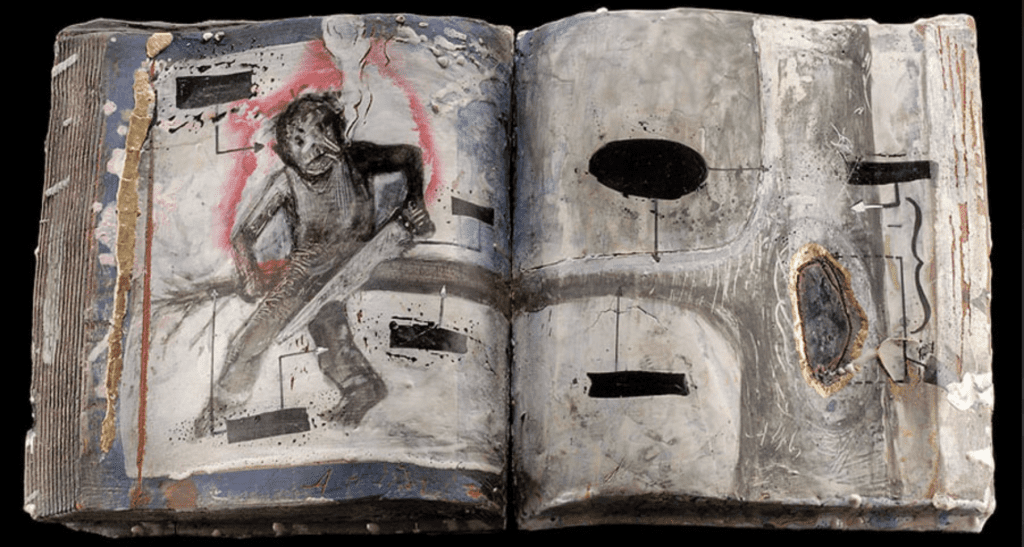
I have been conducting interviews with artists in their studios, now virtually, and have learned just how different we are but also in what ways we are similar. My interview with Arthur was on August 19, 2020 and lasted about an hour and a half. Our conversation meandered over many topics but one thing that stood out to me was that Arthur is entirely in the moment, there is no barrier between what he is saying and what he is thinking. Unlike some of the write-ups of these interviews, I decided not to do much editing but to just let it flow as it happened, to preserve what I think is essential about Arthur’s personality and manner of thinking.
How long have you known Harry?
I don’t know him at all but I was invited to be in the show. It’s strange. I have never shown in Oakland but I live in the Bay Area. So this is a first.
The contrast between your work and Harry’s is very stark.
Yeah, I’ve looked at all his work on-line and he’s a good artist. If you want to know where’s the connection, I think we both traverse the object and the image together.
Yes, and Harry’s process is incredibly labor intensive and time consuming.
Yeah, I can relate to that too. I started off as a painter and many of my teachers were photorealists of the time. So, yes, I can relate to that tightness and the procedure, analytical, almost surgical, and so I have that in my toolbox, so to speak, but that’s not who I am.
You rebelled against that?
I actually had to, I didn’t have an alternative after I finished my bachelor’s degree and began applying to masters programs it didn’t go anywhere, I kept getting rejected. It made me rethink what was I doing and also I knew there was something in me that I wanted to explore but I didn’t know what that was yet.
So I see the reference on your website to both Robert Arneson and Manuel Neri and that informs me a great deal about your work. (A discussion followed about the sometimes painted surfaces of Neri’s figurative works and the raw, gritty nature of Arneson’s). So let’s talk about the process.
Yeah, everything is coiled and hollow, and slab. What you’re seeing is just my hand. I can’t help… I mean it isn’t intentional for the most part; it’s not like I go in saying to myself, “OK Arthur, you gotta keep it rough.” I don’t have those conversations with myself. I’m not concerned about that because what you’re seeing is that nature that was not there when I was a painter. And the reason I didn’t get accepted in a graduate school anywhere, even though I was making these decent photorealistic paintings, was “Who is this person? I’ve seen these paintings before,” and there was nothing special about them. And so, “How do I find the thing about who I am?” And so I had to go off on a different tangent and, also, I had always liked the object. But being schooled as a painter, it was a serious pursuit, anything else was considered a preoccupation.
So how did you make this shift from painting to three-dimensional objects? Was it a cognizant shift?
Yes, it was cognizant in that I paid attention to the objective voice, “What is it that you need?” It’s almost like talking to yourself. And also, “How do I get out of the training,” the only training I’ve had, of photorealism. Well, of course, I don’t start off with the same procedure but I needed alternative steps, something more fresh and spontaneous. And I remember when I was a photorealist painter, ironically, my brushes were a mess. I never cleaned them well. They were always gunky! (Laughter). So what was missing with the painting was the adventure, “What was it going to look like in the end?” I already knew what it was going to look like. So the way I worked myself out of that, I noticed that the rectangular canvas was a real stoppage, so, yeah, I transitioned when I saw clay and I began doing clay slabs and oil painting on them and organically shaped and the edge (of a canvas) was holding me back.
OK, so with that in mind, let’s look at 8 Days in June.
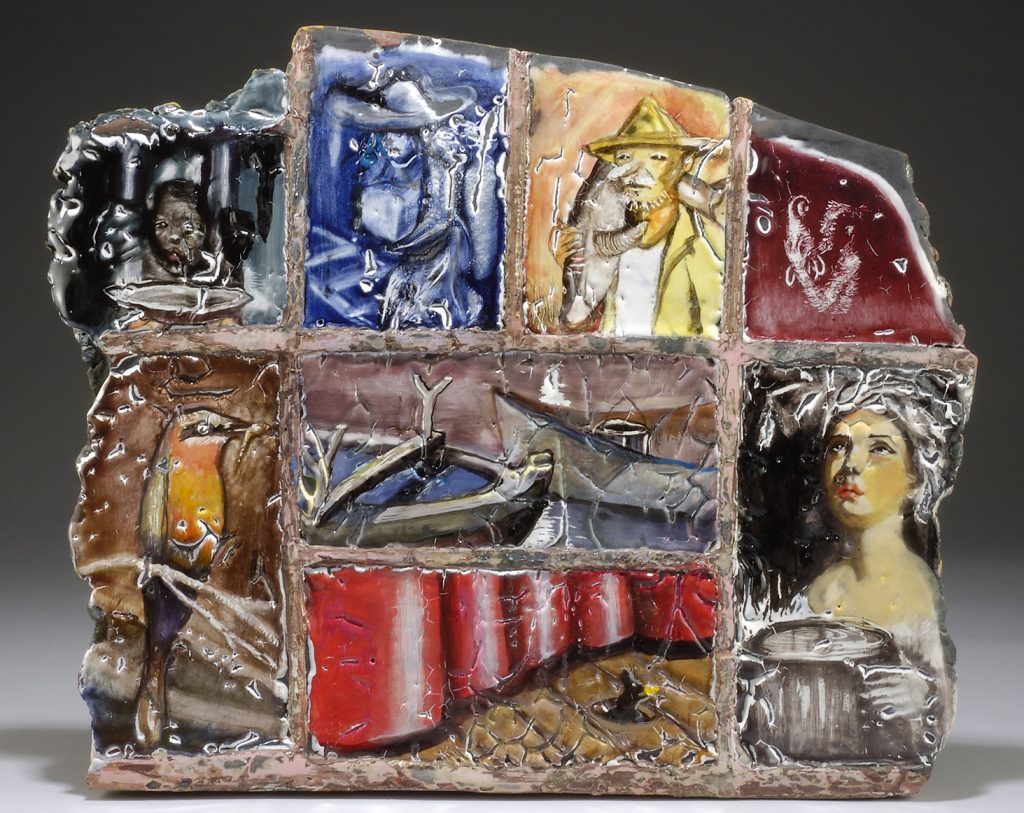
It’s a slab. It is a sort of revisiting of what I was talking about way back in the day. I was slinging a slab in the back yard and when I pulled it up it had the markings of the brick that covered the yard and there were these eight spaces. (Long discussion about firing, bisque, glazing, etc.). This piece was a huge mistake but a consistent mistake that worked well. (Despite the seemingly random nature of the glazing, Arthur described a meticulous process and technique to arrive at the finished piece.). So there is a lot of crawling where there is a break in the fired glaze and most galleries, especially ceramic galleries, don’t want that and think it’s a mistake. Oh my god, are we still thinking like that! Another example is that if you have a crack in a piece, you can drill a hole a little ahead of it and it will stop the crack from traveling. And I have a piece with five little holes in it and I had fun with it and turned the cracks into things and made it part of the piece. As a painter, I was entrenched with all these dos and don’ts but moving to ceramics was absolute freedom for me.
So let’s talk about some of the images in this piece (8 Days in June.)
These vignettes are from sketches of my own or from my collection of images and I wasn’t giving a lot of thought to it, it was just eight images and I did one image for each of the eight days. I always like images of people carrying things because you are catching them in the middle of something and it’s also a voyeur sort of thing, it’s a moment in time. There is nothing intentional about the images. (But all these images are somehow related.). Yeah, the images are related in different ways. Several are holding things. And compositionally, they are turned inward. The woman on the right bottom and the bird at the bottom left are turned inward. (Yes, it would not have worked at all if one was facing outward.)(And the woman at bottom right seems saintly to me.). Yes, the passion of St. Teresa. Yes, it’s taken from one of those paintings. (For me, it has something to do with suffering or even persecution.)
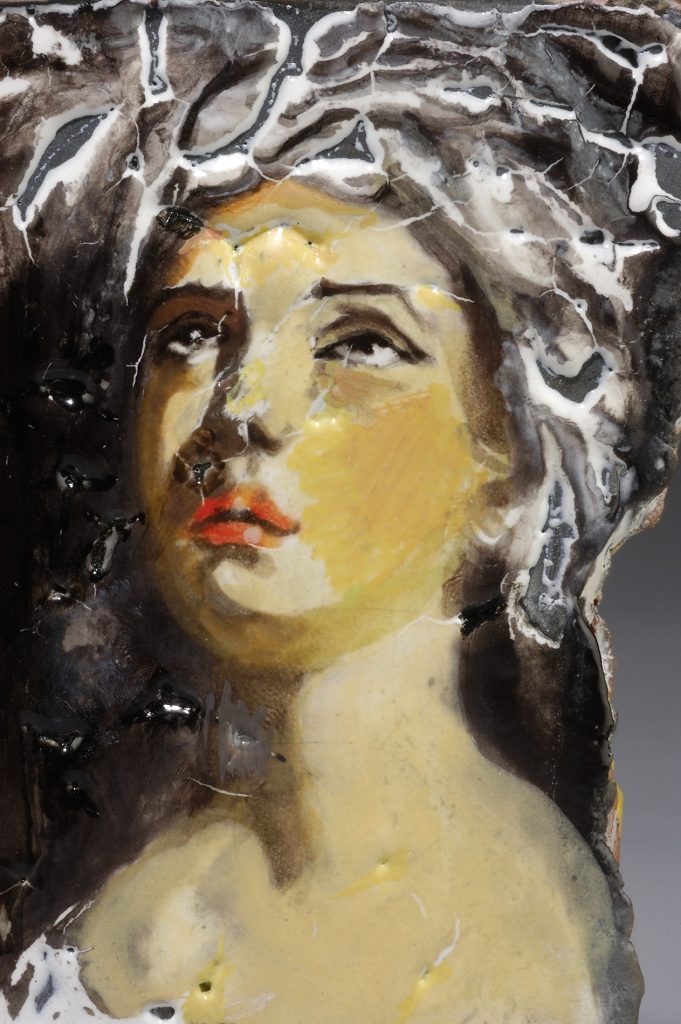
Let’s talk about Prodigal Son.
(So I’ll just tell you what I see. It looks like the bow of a boat but the thing in the middle really perplexes me. It could be a hole in the trunk of a tree, or a vagina, or a spooky tunnel into the netherworld.). So I was living in New York but moved back to California with my girlfriend and then was going back and forth and this might explain that it represents a movement (the bow of a canoe). Travel. And it’s male/female, a symbol of my bi-coastal life. But the traveler began to plant roots so there is the tree imagery and the boat is like a teepee or home and it’s covering over the maternal or female element. (So it goes back to this idea of male artists being intrigued with their female counterparts.). Yeah, as being a part of themselves.
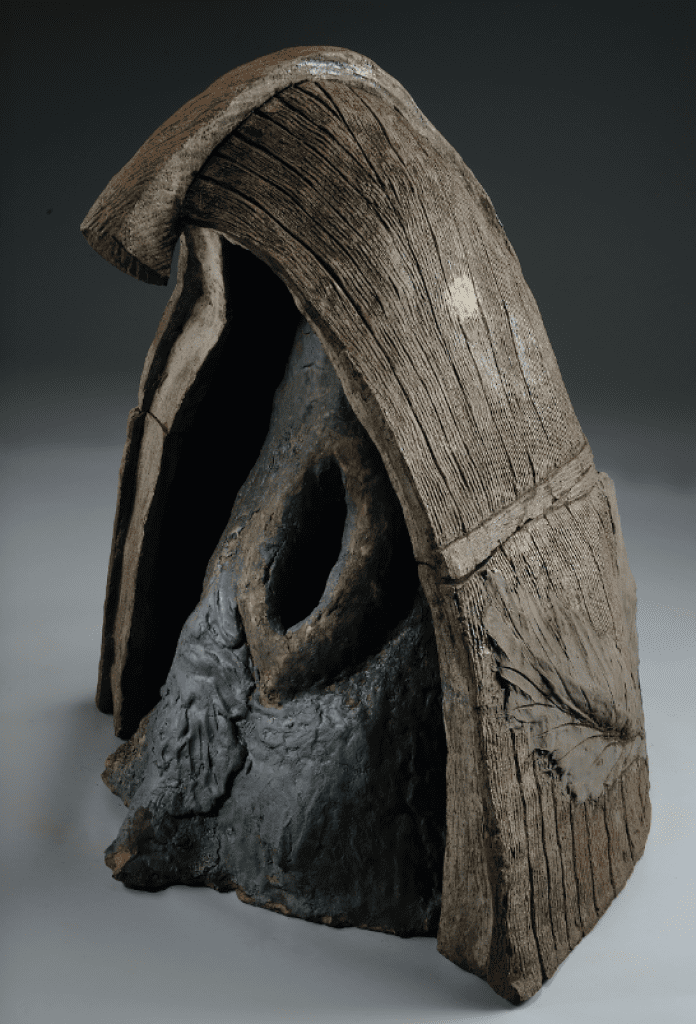
Scapula. This piece, first of all, I have some technical questions. I understand the figure and the base are made of clay but what is the scapula made of?
It’s a plastic casting from a real scapula but I don’t know of what animal. This is from the Pinocchio Series (She’s holding a head…), the idea of the original story which was a baroque art idea already, very dark, and so I made it into a baroque image…. Like John the Baptist (Yes, I think I saw some heads on platters on your website…).

Right. So this is an offshoot from that series and she is either like a fairy or an angel. I used to call them “fallen angels” but that’s not correct; like they’re missing one wing, and the reason I originally thought that was that one wing is a directional device and two, in a funny way, gives it away. But “fallen angels” is the wrong term. It’s more like “lost angels.” (More like “injured angels.”). I like that. I think I’m going to call them “injured angels.” And I’m using mixed media to make a point. If I see another object that does a better job than clay, I’ll use it.
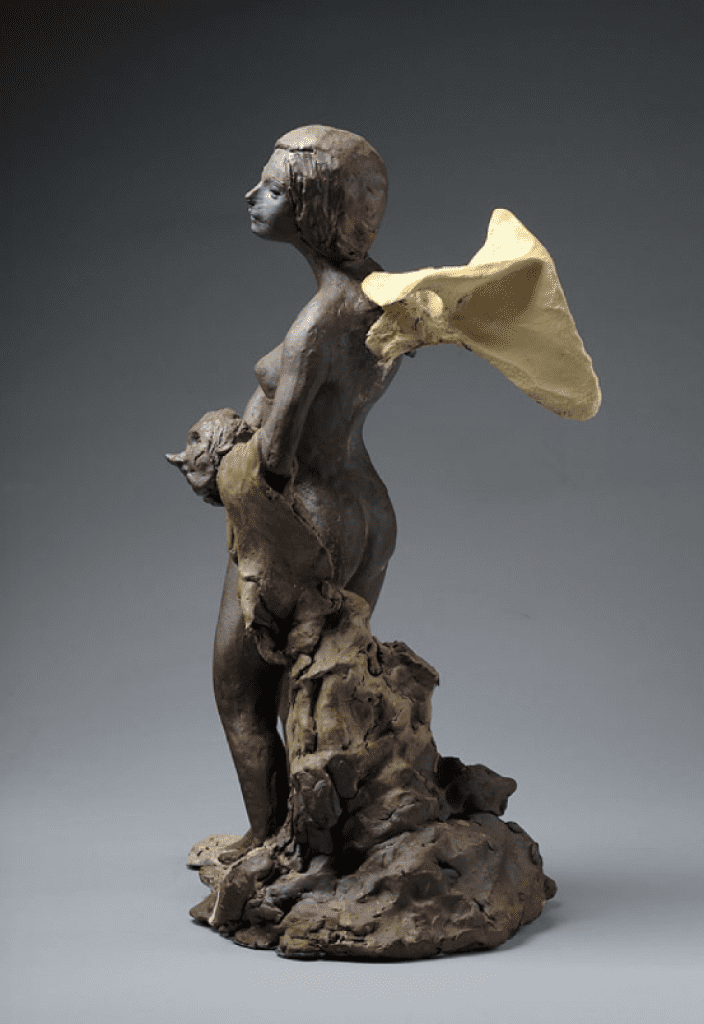
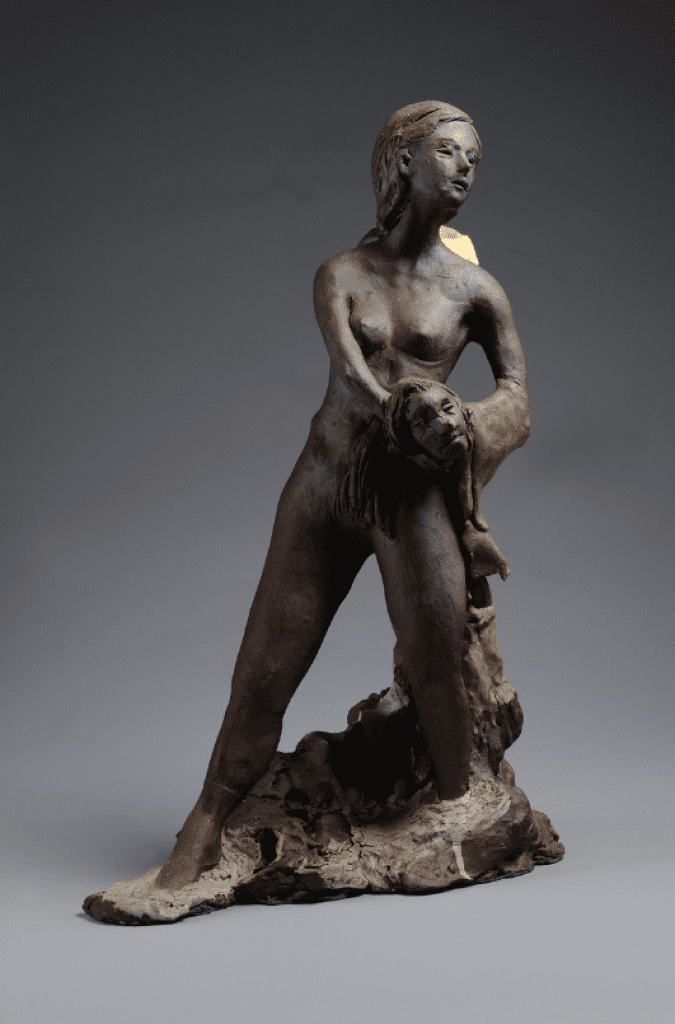
Do you still paint at all?
Absolutely. (So let’s talk about The Taming.). It’s the concept of taming. Yeah, one face is the interpretation of a painting. (A sea monster, right?). Yeah, and I added the kid on top. (It’s very painterly.). Yeah, this was made with a majolica glaze. (The colors are so gorgeous.)(Now, the shape of the thing is curious to me.). It’s actually taken from the shape of the inner ear but it’s so mutated that you can’t see that anymore. It’s a personal symbol that I use and I mess with it here and there and, down the road, it takes on its own identity. It’s part of a series. The series is called Borderland because of what a painting and a sculpture mutation look like. (What’s the story with the votive candle?). I was raised Catholic and I love the look of the votive candle but there’s the idea of doing this kind of a project where you’re saying, “What is the dominant side, is it a painting, or is it the object?” It’s the pursuit of the ideal and you’re going down this road and I’m using the votive candle to suggest that this could be the more important part. But the thing is, the imagery always wants to dominate. So putting the candle on what you might think of as the backside, subordinates the painted side. And if the gallery permits, I light the candle. That’s something I think about with my figures, what time of day it is, and I have a light source coming through. (Ah, so the candle-side is the night-side and the sea monster is the day-side.). Right, right. So if I am putting color down it isn’t just color, it’s representational of time of day and contributes to the feeling of the piece.
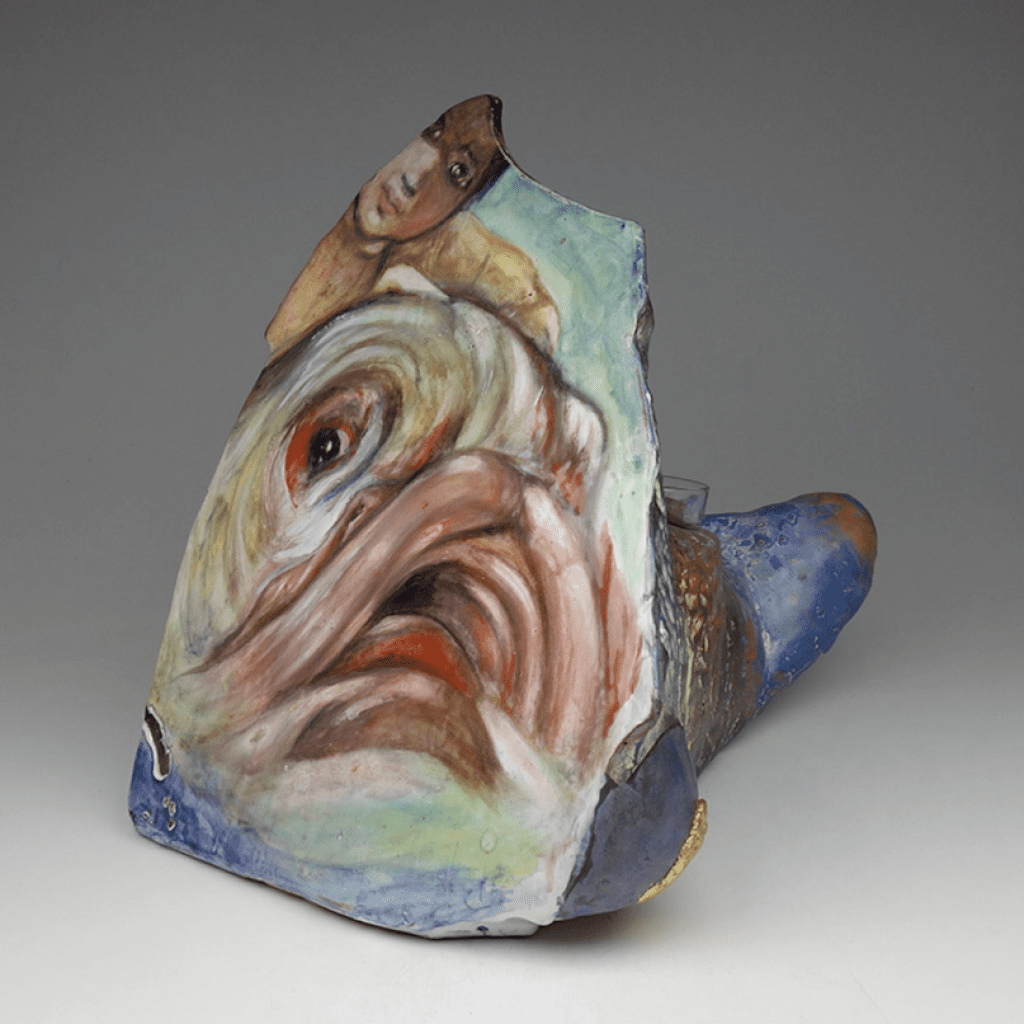
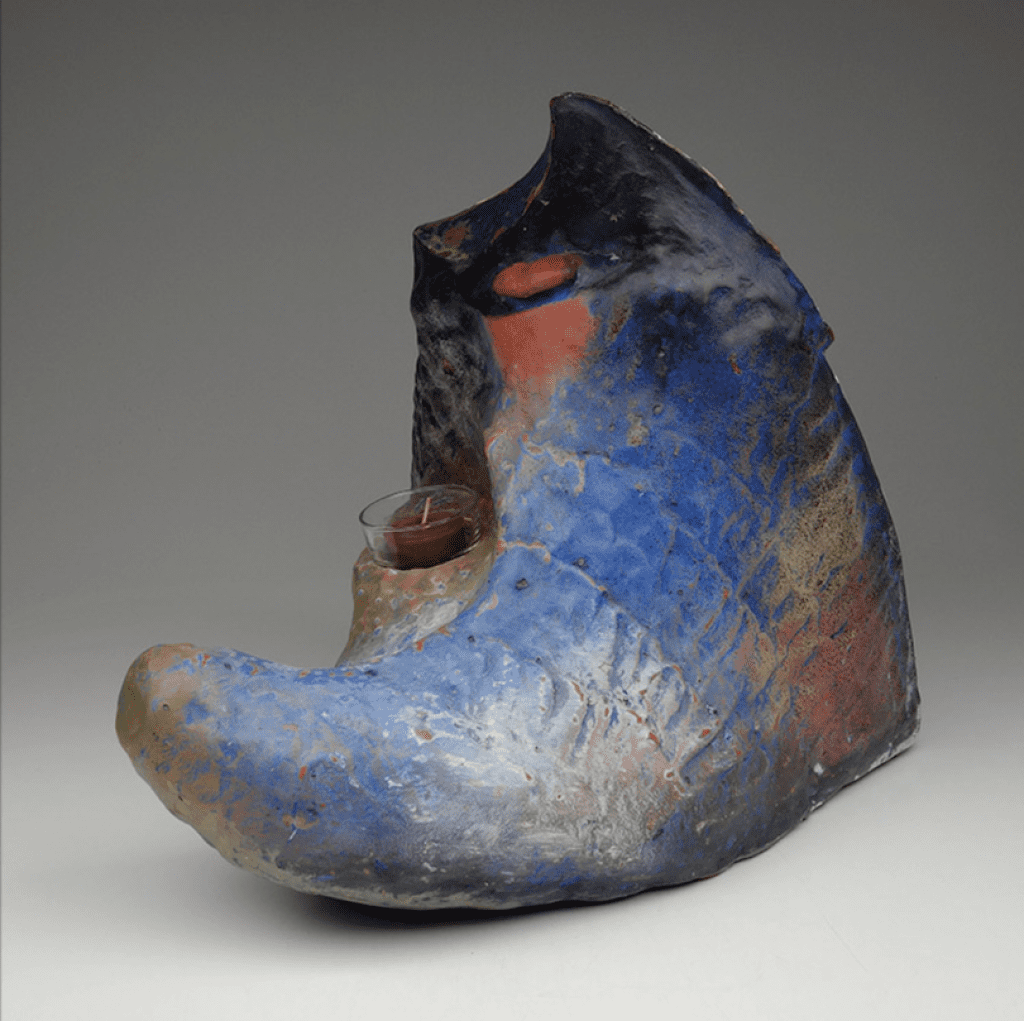
Do you ever approach a piece as an abstraction?
No. I use abstraction as a tool, as a delivery device. I think Francis Bacon said something like “abstraction is just decoration.” (Long discussion of how some great artist’s have been terrible family men; could be another entire interview. There’s a stereotype of the artist whose first priority in life is his art and everything else comes second.).

You have mentioned a number of artists in our conversation: Arneson, Neri, Philip Guston, Bacon and others. Who are the artists that have informed your career?
I think of people more in terms of their contribution, their behavior, not their personal behavior but their career in terms of making a difference. Philip Guston is a good example. He eventually followed his own voice. He went with his friends and had a mint career of abstract expressionism but then basically invented his own personal hybridization of cartoons and painting and brought it all together. When he stopped painting paintings that were just about paint [I love that phrase!] he was asked why and he said that he “got tired of all that purity.” (Well, I’ve always thought of those painters, the abstract expressionists of the 1950s, that many of them reached a dead end. They didn’t know where to go from there and some of them, like Pollock, just decided to check out. I mean, how many drip paintings could he have made?). Yeah, and it’s very hard for an established artist to go ahead. It’s like Bob Dylan going electric. He went touring and they booed him but he’s like, “So what?” He has an amazing understanding of who he was and is. He really got it and became impervious. When I think of Guston and Dylan it is really important for me to see that spirit. It’s interesting to look at the Bay Area figurative painters that were so important. They were looking to New York and the photos that were coming from there were mostly in black and white, in the magazines, and they are interpreting them as extremely colorful with really thick paint but, for the most part, they are not as colorful as that and the painting is thin, so they made their own interpretation. And the key thing is that the California painters couldn’t let go of the figure. So Richard Diebenkorn was doing figurative work but eventually, he went abstract with his Ocean Park Series. So he’s also someone I admire. (So I think of Willem de Kooning who went from those raw figures to the lyrical, light, poetic paintings at the end.). Yeah, it makes absolute sense. (We went back to talking about Bacon.). What I love about Bacon is that the paintings are so composed. It’s like, sometimes he really wants the eye to go from “here to there,” you know, so he puts an arrow. He’s saying, “Look there!” So to answer your question, I really like people (artists and their work) when I look at them and like the way the person thinks, you can see where they came from and where they’re going. Another one that comes to mind is Frank Stella. He was a minimalist and addressing the concept of space, almost an anti-statement about space, “How flat can I go?” So like all those minimalists, you’re going to eventually fade away or you have to find a way to transition and he began making his work more dimensional and finally almost exploding off the wall. [Stella’s often huge sculptural wall and free-standing pieces come to mind.] It’s like an alternative universe. But why not, he already answered the question so why not look at another way of answering it. It’s another way I look at my Borderland Series. What happens when a painter exists in sculptural ideas?
I always end these interviews with a question that I think you may think is a stupid question but I’ll ask it anyway. Why do you do it?
Honestly, it’s a really short answer. It’s to keep my sanity. When I go into the studio I literally feel sanctuary. I have experience in knowing that the unknowns can be answered in a small way today if I focus on it and sometimes even when I’m not focused. I’ll be daydreaming and two things will come together and they both complete themselves, so to speak. So I have a lot of pieces hanging around waiting for me to find the answer for them.
So given the fact that we are in this pandemic and the whole world seems f**ked up, does that influence you?
So sometimes I have a more intellectual idea to use and that is a pragmatic way of making work. So, for instance, for a long time, I was using the inner ear as a symbol. Someone gave me a picture of it and I thought, “Wow, that is an amazing thing.” It’s a crazy object. And you need your inner ear for balance. And, you know what, I actually need…. I mean I’m always trying to find how to keep the day in balance. So that’s different from the old school dudes who went to the studio for twelve hours and locked the world out. The world is inclusive. So I was using the inner ear as a metaphor or an idea for about ten years or so and then, one day, I got vertigo. So now I am looking at tutorials about how to cure vertigo and I see this doctor holding a model of the inner ear and it’s like one of my sculptures (laughter). So I’m thinking, now it’s become real. So now I’ve changed an objective to a subjective, now I have experience with it. So in my work, I like to make something that is very understood but there may be another element that other people don’t know what it is. And that’s the unknown. I don’t like explaining everything. I want the unknown. Why would anyone want me to tell them the last chapter of the book? So the answer to your question is that now I can use the metaphor in a subjective manner, not in an objective manner. We are in the unknown. We don’t know the f**k what’s going to happen. So how do you depict the unknown?
